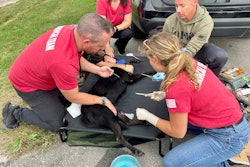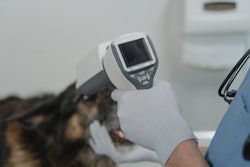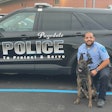 Taking proper care of a police dog's paws can increase their effectiveness on duty.Pexels
Taking proper care of a police dog's paws can increase their effectiveness on duty.Pexels
Pay attention to a dog’s feet, stresses Lyn Schuh, CVT, operations manager of Operational K9 Medical Team of Wisconsin (OPK9 Medical Team).
She explains that police K9s can injure their paw pads, causing painful walking and potential infections, while mats between their toes can cause walking difficulties and skin issues if licked.
Schuh highlights the importance of foot care for police dogs, as K9s absorb things through their feet. She stresses that it is a daily responsibility for K9 handlers to ensure their partners' feet are well-maintained.
The OPK9 Medical Team instructor suggests how police officers can keep their dogs' paws healthy. Combined with additional information from an article on PreventiveVet.com, here are seven tips to keep police K9s' paw pads in great shape.
1. Check Paw Pads Regularly
To inspect a dog's paws, gently spread their toes apart. Look for injuries, foreign objects like burrs or pebbles, and dangerous foxtails. Check the sides of their paw pads and between their toes. Also, look for any swelling or discoloration. Pay attention to any signs of pain or tenderness while examining the foot.
Schuh recommends checking a dog’s feet before and after every shift. Many dogs, she says, get burrs in their toe pads when working outdoors.
In New Mexico, for example, there is a plant called goathead, a fast-growing plant that forms dense mats and produces sharp burrs. “These burrs can actually go through flip-flops worn by humans,” she says. “Imagine what they can do to a dog’s feet. When a dog is tracking, they are on multiple surfaces, and their feet can easily get injured. That’s why you need to look at those feet.”
2. Avoid Walking On Hot Pavement
Hot pavement or asphalt can burn a dog's paw pads, PreventiveVet.com reports. Police can assess pavement temperature by placing their hands flat for 7 seconds. The article notes that if it’s too hot to keep their hands flat on it, it’s too hot for their K9 partner to walk on it.
3. Remember Seasonal Paw Care
“Cracked paws are the No. 1 thing, either from dryness or seasonal exposures, such as salt in the winter and heat in the summer,” Schuh says. “When paw pads are cracked, dogs will like and lick and lick at their feet.”
She stresses that winter can be especially tough on K9 paw pads. Ice melt products can cause paw pads to dry out, crack, or even burn, PreventiveVet.com adds. If a dog licks its paws, these products can also be toxic. It's best to avoid walking dogs on salt-treated sidewalks if possible.
PreventiveVet.com shares that keeping a dog's paw pads trimmed of excess fur between their toes ensures they will not collect paw "snowballs" between their toes as easily. These snowballs form when snow and ice get wrapped up in dog fur, melt from their body heat, and then re-freeze. PreventiveVet.com points out that snowballs on a dog's feet and legs can cause a lot of pain and discomfort since they push their toes apart and pull on the hair.
After any outdoor excursion, particularly on salt-treated surfaces, PreventiveVet.com says to remember to wash and dry the dog's paws. If their paws have collected snowballs, apply paw wax to slide the ice from between their toes before washing them with warm water.
4. See the Vet
Have a veterinarian examine the police dog's paw pad if there are any abrasions or cuts to prevent infection. To protect it during the healing process, PreventiveVet.com recommends wrapping the dog’s paw or cutting a silicone scar sheet to the shape of the affected pad and applying it.
However, Schuh warns improper bandaging can also be an issue. Many times, she says, when officers bandage a dog’s feet, they bandage them too tight or with items that are not bandage material. “This can cause swelling,” she says.
5. Keep Nails, Paw Pads Trimmed and Mat-Free
“We see a lot of nails that are too long and fur that is overgrown between the pads,” Schuh says. Keeping the fur that grows between a dog’s paw pads nice and short can help keep their feet healthy and provide more traction on slippery surfaces, according to PreventiveVet.com.
The site adds that trimming fur on paw pads makes inspecting and cleaning their paws easier and prevents ice build-up in snowy weather. It also prevents matting, which limits the urge to chew at their feet and develops skin conditions.
Schuh adds that it's also vital to keep a dog's nails short. Too long nails can change how dogs stand and walk, putting uncomfortable pressure on their feet and joints, PreventiveVet.com shares.
6. Watch For Hyperkeratosis
Do the dog’s paw pads look rough, thick, or crusty? This condition is called canine hyperkeratosis and may be seen on their paw pads or their nose. Hyperkeratosis can be genetic or the result of an underlying medical condition, so it's important to speak with a veterinarian about it. PreventiveVet.com suggests using paw pad balm to moisturize and protect the dog's paws, reducing discomfort.
7. Ripped Paw Pad Treatment
“We see a lot of lacerations that go unnoticed,” Schuh says. Ripped paw pads happen. When they do, Schuh says the best solution is to help it heal quickly.
PreventiveVet.com recommends bathing the affected paw pad in warm water containing Epsom salts for 15 to 20 minutes daily until the healing process starts. The article reports that the area should be thoroughly rinsed and dried completely, and triple antibiotic ointment should be applied twice daily.
By taking these steps, officers can improve the health of their K9 partner’s feet. If a police dog's paws hurt, the K9 officer will not perform at their best. So, make paw pad care a regular part of police duty.


















